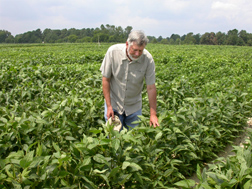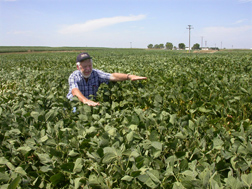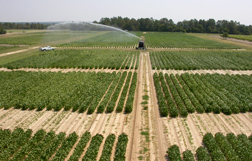Drought-Hardy Soybean Lines Show Their Stamina
Rows and rows of drought-stricken soybean plants lined test plots in the Sandhills area of North Carolina. So when a cloudburst came along, you’d have thought that Thomas Carter, who planted the seeds with his co-workers, would be happy. But he wasn’t.
The rain clouds put a damper on Carter’s tests, because his goal is to pinpoint new soybean breeding lines that perform well under drought conditions rather than heavy rainfall. “It’s just something you face doing this kind of work,” he says. While Carter can’t change the weather, he is trying to reduce the damaging effects of drought on U.S. soybean yield.
Carter is a plant geneticist at the USDA-ARS Soybean and Nitrogen Fixation Research Laboratory in Raleigh, North Carolina. For more than 25 years, he has been mining genetic diversity, found within the USDA Soybean Germplasm Collection, to fuel his drought-tolerance research.
Carter and his team have been transferring a slow-wilting characteristic from Asian landraces into U.S.-adapted varieties. Once the team gets the slow-wilting trait into a high-yielding line, they share the new line with private seed companies and public soybean breeders.
“Industry breeders use the USDA drought-tolerant lines as valuable breeding stock to develop high-yielding varieties adapted to the stressful U.S. summers,” says Carter.
|
|
The Best Place To Mine
“The ancestral home of the soybean is China,” says Carter. “Going back some 3,000 to 5,000 years, Chinese farmers domesticated the first primitive soybean varieties from the wild soybean, Glycine soja. Throughout these millennia, Chinese farmers produced upwards of 20,000 diverse Asian landraces of G. max, which later became the backbone of modern soybean breeding worldwide.
“In the United States, farmers have been growing soybeans for only about 100 years. During that time, the genetic base among U.S. varieties has remained relatively narrow. We have not added enough new genetic diversity to the U.S. crop.”
To find diversity within a particular plant species, such as soybean, the place to look is its original home. “It’s generally agreed that the location where a crop has been domesticated tends to be its center of diversity,” Carter says. So it’s no wonder that he looked to exotic plant introductions from the Far East for the slow-wilting soybean trait he sought.
“Adding diversity into breeding programs is important, because a wider genetic base can help protect our food supply from a variety of potential threats,” says Carter. “For example, there is concern among experts that higher temperatures and drier soils—caused by global climate change—could diminish crop yields. If fluctuations in rainfall increase drought conditions, it will be even more important for farmers to have access to wilt-resistant varieties.”
A close look at soybean’s historical roots and migration to the United States sheds light on how today’s U.S. soybean production originated from a narrow genetic base.
Back to the Roots
“In 1898, USDA’s Bureau of Plant Industry began documenting foreign plant germplasm that was introduced into the United States,” says Randall Nelson. He is curator of the USDA Soybean Germplasm Collection on the University of Illinois campus at Urbana-Champaign. “Our U.S. commercial soybean crop is based on just a few foreign plant introductions that were brought into the country beginning in 1901,” he says.
U.S. soybean production began slowly in the 1920s with G. max, around the same time that USDA was sending plant explorers to Asia. Over the next decade, those explorers brought back more than 5,000 different types of soybeans. “Because there was no system to preserve these soybeans, nearly 80 percent of them were lost,” says Nelson. “The survivors became part of the USDA Soybean Germplasm Collection when it was established in 1949. Today, the collection has grown to 17,000 foreign plant introductions, and it also includes germplasm of the original wild soybean, genetic stocks, and U.S. cultivars. All told, the collection numbers 20,700,” says Nelson.
It was in the early 1980s, when soybean production had reached 70 million acres, that Carter first began studying the treasure trove of Asian soybean plant introductions housed in Urbana, looking for rare types that express the slow-wilting form of drought tolerance. He tested a wide range of exotic soybeans in the ideal sandy soils of the Sandhills Research Station, operated by North Carolina State University.
His patience has paid off. After screening more than 2,500 exotic plant introductions from the germplasm collection, he has identified 5 that consistently stand up to drought.
Looking at Every Seed
Today, Carter heads “Team Drought,” a group of researchers at five universities in five different states, who have been collaborating since 1992 to develop drought-tolerant soybean lines.
Carter and Team Drought aim to screen all relevant exotic plant introductions in USDA’s soybean germplasm collection. “We want to develop drought-tolerant breeding lines across a range of maturity groups so we can apply these developments to all of the soybean-growing areas of the country,” he says.
U.S. soybean genotypes are classified into 13 “maturity groups,” which represent areas of adaptation generally corresponding to latitude bands. Carter has already grown almost all of the collection’s more agronomic accessions in maturity groups V, VI, VII, and VIII in North Carolina. In 2000, he began working with Team Drought collaborators Jim Orf in Minnesota and Jim Specht and Nebraska to screen lines from maturity groups I though IV. Slow-wilting types have been found in these groups as well.
Using conventional breeding methods, Carter and his team develop hundreds of new breeding lines each year, for a total of more than 5,000. Five of them have stood out for further development and are now in validation trials across the South. Based on the results of these tests, the team will soon release advanced breeding lines that carry the slow-wilting trait and also show good yield potential when rainfall is plentiful.
The slow-wilting lines yield 4 to 8 bushels more than conventional varieties under drought conditions—depending on the region and environment, says Carter. For example, under drought conditions, normal soybeans yield 30 bushels per acre, but slow-wilting types yield about 35 bushels per acre.
The Team Drought project is funded by ARS and a grant from the United Soybean Board.—By Rosalie Marion Bliss, Agricultural Research Service Information Staff.
This research is part of Plant Genetic Resources, Genomics, and Genetic Improvement (#301), an ARS national program described on the World Wide Web at www.nps.ars.usda.gov.
Thomas E. Carter is at the USDA-ARS Soybean and Nitrogen Fixation Research Laboratory, 3127 Ligon St., Raleigh, NC 27607; phone (919) 513-1480, fax (919) 513-4598.
"Drought-Hardy Soybean Lines Show Their Stamina" was published in the November/December 2008 issue of Agricultural Research magazine.









